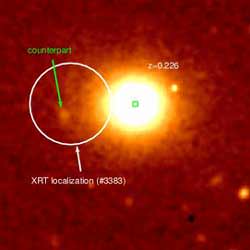
GRB 050509B, detected on 9 May 2005, was a *very* short burst, lasting just 30 milliseconds. Image credit: NASA/JPL. Click to enlarge.
After 30 years, they finally caught one. Scientists on Monday have for the first time detected and pinned down the location of a so-called “short” gamma-ray burst, lasting only 50 milliseconds.
The burst marks the birth of a black hole. The astronomy community is buzzing with speculation on what could have caused the burst, perhaps a collision of two older black holes or two neutron stars. A multitude of follow-up observations are planned; the answer might come in a few more days. “Everything about this gamma-ray burst so far supports the merger theory,” said Steinn Sigurdsson, associate professor of astronomy and astrophysics at Penn State and a gamma-ray-burst theorist.
Gamma-ray bursts are the most powerful explosions known in the universe. Recently, the longer ones — lasting more than two seconds — have become easy prey for NASA satellites such as Swift, built to detect and quickly locate the flashes. Short bursts had remained elusive until Monday, when Swift detected one, autonomously locked onto a location, and focused its onboard telescopes in less than a minute to capture the burst afterglow.
“Seeing the afterglow from a ‘short’ gamma-ray burst was a major goal for Swift, and we hit it just a few months after launch,” said Neil Gehrels, Swift project scientist at NASA Goddard Space Flight Center in Greenbelt, Maryland. “Now, for the first time, we have real data to figure out what these things are.”
Like clues left at a crime scene, the afterglow contains information about what caused the burst. Most scientists are convinced short and long bursts arise from two different catastrophic origins. The longer bursts appear to be from massive star explosions in very distant galaxies. The shorter ones — less than two seconds and often just a few milliseconds — are the deeper mystery because they have been simply too fast to observe in detail.
The Monday burst is called GRB 050509B. Swift’s X-ray Telescope detected a weak afterglow that faded away after about five minutes. Swift’s Ultraviolet/Optical Telescope did not see an afterglow. Ground-based telescopes have not yet definitely detected an afterglow either. In contrast, afterglows from long bursts linger from days to weeks.
All of this fits the pattern of a collision between some combination of black holes or neutron stars, both of which are created in the death of massive stars. Neutron stars are dense spheres about 20 miles across. Black holes have no surface and are regions in space of infinite density. Theory predicts that these kinds of collisions wouldn’t produce a long afterglow because there isn’t much “fuel” — such as dust and gas — from the objects and in the region to sustain an afterglow.
GRB 050509B appears to have occurred near an unusual galaxy that has old stars and is relatively nearby–about 2.7 billion light years away–which also is consistent with the theory that short bursts come from older, evolved neutron stars and black holes. In contrast, longer gamma-ray bursts tend to be in young, distant galaxies filled with young, massive stars — remnants of the early universe.
“We are combing the region around the burst with the Keck Telescope for clues about this burst or its host galaxy,” said Shri Kulkarni, a gamma-ray burst expert at Caltech. “What we are seeing so far is what proponents of the merger theory have been saying all along.” Such an evanescent afterglow has been expected in the most popular model for short hard bursts to date. Additional observations are planned for NASA’s Hubble Space Telescope and Chandra X-ray Observatory.
Swift is a NASA mission in partnership with the Italian Space Agency and the Particle Physics and Astronomy Research Council, United Kingdom; and is managed by NASA Goddard. Penn State controls science and flight operations from the Mission Operations Center in University Park, Pennsylvania. The spacecraft was built in collaboration with national laboratories, universities, and international partners, including Penn State University; Los Alamos National Laboratory in New Mexico; Sonoma State University in Rohnert Park, California; Mullard Space Science Laboratory in Dorking, Surrey, England; the University of Leicester in England; Brera Observatory in Milan, Italy; and ASI Science Data Center in Frascati, Italy. For more information about this and other Swift-detected bursts, refer to http://grb.sonoma.edu.
Original Source: Eberly College News Release
